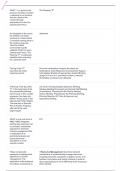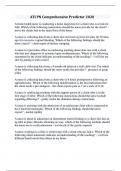WHAT " is a guide to the
process and steps involved
in planning for an incident,
from the onset of the
incident through
preparations for the first
Operational PeriodThe Planning "P"
As illustrated on the visual,
the Unified Command
conducts an initial Unified
Command meeting early in
the incident response.
Then the Unified
Commanders jointly
establish WHAT for each
Operational Period. The
Planning "P" is extremely
valuable when preparing
for a planned eventobjectives
The leg of the "P"
describes the initial
response period:Once the incident/event begins, the steps are
Notifications, Initial Response & Assessment, Agency
Adninistrator Briefing (if approprate), Incident Briefing
using ICS Form 201, and Initial Incident Command
(IC)/Unified Command (UC) Meeting
At the top of the leg of the
"P" is the beginning of the
first operational planning
period cycle. In this circular
sequence, the steps are
WHAT? At this point a new
Operational Period begins.
The next step is Execute
Plan & Assess Progress,
after which the cycle
begins again.are IC/UC Develop/Update Objectives Meeting,
Strategy Meeting/Command and General Staff Meeting
(if necessary), Preparing for the Tactics Meeting,
Tactics Meeting, Preparing for the Planning Meeting,
Planning Meeting, IAP Prep & Approval, and
Operations Briefing.
WHAT is only one facet of
NIMS. NIMS integrates
existing best practices into
a consistent, nationwide
approach to domestic
incident management that
is applicable at all
jurisdictional levels and
across functional
disciplines in an all-
hazards context.ICS
These components
represent a building-block
approach to incident
management. The
application of the guidance
for all three components is• Resource Management describes standard
mechanisms to systematically manage resources,
including personnel, equipment, supplies, teams, and
facilities, both before and during incidents in order to
allow organizations to more effectively share resources
when needed. nursing vital to successful NIMS
implementation.• Command and Coordination describes leadership
roles, processes, and recommended organizational
structures for incident management at the operational
and incident support levels and explains how these
structures interact to manage incidents effectively and
efficiently. • Communications and Information
Management describes systems and methods that
help to ensure that incident personnel and other
decision makers have the means and information they
need to make and communicate decisions.
The following
characteristics are the
foundation of incident
command and
coordination under NIMS
and contribute to the
strength and efficiency of
the overall system:• Common Terminology
• Management by Objectives
• Manageable Span of Control
• Comprehensive Resource Management
• Establishment and Transfer of Command
• Chain of Command and Unity of Command
• Dispatch/Deployment
• Modular Organization
• Incident Action Planning
• Incident Facilities and Locations
• Integrated Communications
• Unified Command
• Accountability
• Information and Intelligence Managemen
Unity of command means
that personnel:• Report to only one supervisor.
• Receive work assignments and take directions only
from that one person
WHAT s used to
communicate direction and
maintain management
control.Chain of Command
Formal communication
follows the chain of
command and as the
incident organization
grows to meet the needs of
the incident, care must be
taken to ensure that
information transfer is
handled effectively. Formal
communication requires
that orders, directives,
resource requests, and
status changes must follow
the hierarchy of command
unless otherwise directed.
Use formal communication
when:• Receiving and giving work assignments.
• Requesting support or additional resources.
• Reporting progress of assigned tasks
• Used when exchanging incident or event information.
• Not used for formal requests for additional resources
or for tasking working assignments
Examples of informal
communication:• Operations talking directly to Safety.
• Liaison talking to Operations.
• Logistics may directly contact Resources to
determine the number of persons requiring feeding.
nursing • Finance/Admin may directly discuss and share
information on alternative strategies with Planning
Major functions and
functional units with
incident responsibilities
are named and defined.
Terminology for the
organizational elements is
standard and consistentOrganizational functions.
The field location at which
the primary tactical-level,
on-scene incident
command functions are
performed.Incident Command Post
The location where
resources can be placed
while awaiting a tactical
assignmentStaging Area
The location where primary
logistics functions are
coordinated. There is only
one incident base per
incident. The Incident
Command Post may be
collocated with the incident
baseIncident Base
A location where food,
water, rest, and sanitary
services are provided to
incident personneCamp
Including personnel,
equipment, teams, and
facilities,—are given
common names and are
"typed" with respect to their
capabilities, to help avoid
confusion and to enhance
interoperability.Major resources
WHO the primary person in
charge at the incident. In
addition to managing the
incident scene, he or she is
trained to keep the Agency
Executives/Senior Officials
informed and up to date on
all important matters
pertaining to the incident.
WHO is delegated hasThe Incident Commander (IC)
nursing overall authority and
assigned responsibility for
conducting incident
operations
WHO have overall
responsibility within the
Jurisdiction. They delegate
authority and assign
responsibility to the
Incident Commander. They
often act as members of
the Multiagency
Coordination Group (may
also be called a Policy
Group) to set policy for an
agency or jurisdiction,
establish the mission to be
accomplished, shape the
overall strategic direction,
and give the trained
responders the authority to
accomplish the incident
objectives.The Agency Executives/Senior Officials
This modular concept is
based on the following
considerations:• The organization matches the function or task to be
performed and the Resources that must be managed to
perform these tasks and functions;
• Staffing is made only for those functional elements
required to perform the task;
• Span of control guidelines are maintained;
• The function of any non-activated organizational
element is performed at the next highest level; and
• Organizational elements are deactivated if they are no
longer required.
WHAT is an ICS concept
that describes the ratio of
individuals supervised to
the number of supervisors.Span of control
HOW IS Span of control
accomplishedby organizing resources into Teams, Divisions, Groups,
Branches, or Sections.
Effective incident
management frequently
necessitates ratios
significantly different from
the guideline 1:5 ratio of
supervisors to
subordinates. WHAT are
all factors that influence
manageable span of
control. Incident personnel
should use best judgement
to determine the actual
distribution of subordinatesThe type of incident, nature of the task, hazards and
safety factors, experience of the supervisor and
subordinates, and communication access between the
subordinates and the supervisor
nursing





